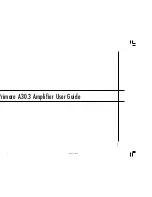
The material contained in this document is the property of Electronics & Innovation Ltd., it is
subject to change without notice.
December 2015
11
Revision F
b)
Calorimetric Power Meter HP434A
c)
Spectrum Analyzer.
d)
Attenuator (20dB)
e)
Attenuator (30dB)
f)
Coupler (30 dB)
2.) Connect the Equipment as shown in Figure 4-2, then
proceed as follows:
a)
Adjust the signal generator to a CW center frequency of 250 kHz, for an
indicated output of 40 watts on the power meter.
b)
Using the spectrum analyzer, check that the level of the carrier
harmonics is less than -20 dB with respect to the carrier while manually
scanning the frequency band of 250 KHz to 150 MHz. An indicated
power output of 50W should be maintained during this operation.
4.5 PACKAGING FOR RESHIPMENT
In the event of the equipment being returned for servicing it should be packed in
the original shipping carton and packing material. If this is not available, wrap the
instrument in heavy paper or plastic and place in a rigid outer box of wood,
fiberboard or very strong corrugated cardboard. Use ample soft packing to
prevent movement. Provide additional support for projecting parts to relieve
these of unnecessary shock. Close the carton securely and seal with durable
tape. Mark the shipping container FRAGILE to ensure careful handling.
Chapter 5 Safety:
Do not attempt to operate this unit with the cover removed. High AC and DC
voltages are present. The cover prevents against electrical shock due to AC line
voltages, high DC and RF fields. Further the cover provides part of the cooling
system design. Components, specifically on the RF driver board are prone to
over-heat and eventual failure if the unit is operated without the cover in place.
Ensure that the load is connected to the output prior to connecting the RF input
to the unit. This will prevent high voltages being present and exposed at the
output connector.
Only use the AC cord provided or equivalent.
Ensure that the mains outlet is properly grounded.
































